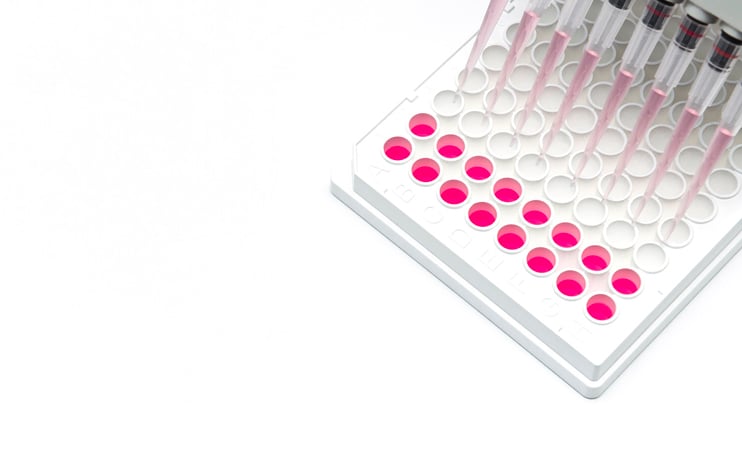The ELISA (Enzyme Linked ImmunoSorbent Assay) is the gold star immunoassay, used to detect the presence of a target protein. It is the standard procedure that all new assay technology is compared to during research and development. The ELISA is also fundamental to most clinical tests for diagnosing disease because it is highly sensitive, and is currently the best characterized and standardized method.
ELISA assay principle
The principle of an ELISA relies on the specific binding between an antibody and antigen. This specificity comes from the unique three-dimensional structure of the antibody paratope and the antigen epitope. These two regions fit like a lock and key, via non-covalent, charge-based, and/ or hydrophobic interactions.
The clinical purpose of the ELISA is to detect either an antibody or antigen from a biological fluid such as blood (serum), urine, or saliva. When the ELISA is used to detect the presence of an antibody, the assay is being used to assess whether the patient has been exposed to a specific antigen.
However, it is difficult to assess a current infection with this method because the body retains antibodies for a long time after infection. Alternatively, an elevated amount of antibody can be used to indicate an active immune response to the pathogen.
ELISA is quantitative, meaning that the actual amount of protein can be quantified. When an ELISA is used to detect antigen presence, it provides a better understanding of current infection as the antigen is only present in an active infection.
Sandwich ELISA steps
The ELISA is composed of multiple steps. Many of these steps are blocking and washing steps in order to prevent non-specific binding. Non-specific binding occurs when proteins adsorb to each other or to the plastic surface of the ELISA plate via off-target interactions. These interactions are also mediated by char
How does an ELISA work?
There are several different ELISA assay techniques, but they all utilize a build-up of antibody and antigen onto the bottom of a 96-well polystyrene plate. The wells are chemically treated to make them ‘sticky’, which increases the ability of proteins to adsorb to the plate’s surface.
ELISA assays rely on an enzymatic reaction between an enzyme-conjugated label and a substrate to produce a colorimetric, chemiluminescent, or fluorescent product. These products are then detected and quantified via a spectrophotometer or fluorometer, providing information about the concentration of target protein in the sample.
An ELISA is composed of multiple steps. Many of these steps are blocking and washing steps in order to prevent non-specific binding. Non-specific binding occurs when proteins adsorb to each other or to the plastic surface of the ELISA plate via off-target interactions. The exact ELISA steps differ slightly between methods, but here we will focus on the sandwich ELISA as an example.
Sandwich ELISA steps
A sandwich ELSIA gets its name from the ‘sandwich’ that is formed with two antibodies and an antigen during the process. Sandwich ELISA steps are:
Step 1: Immobilization of the capture protein
In a sandwich ELISA the capture protein is an antibody, and the target is the antigen. Therefore, the first ELISA step is to immobilize the capture antibody onto the plate. Many ELISA kits are available with the capture protein pre-immobilized.
Step 2: Wash off any un-adsorbed capture protein from the well surface
Washing steps with detergents reduce off-target hydrophobic interactions between proteins and remove unbound capture proteins from the plate.
Step 3: Block any unbound sites on the plate
The hydrophobic interactions between proteins are mediated by charge or hydrophobicity. This means they can be mitigated to some extent by blocking and washing steps.
Proteins are added to the plate, which adsorb to the open sites on the plate’s surface. Proteins such as Bovine Serum Albumin (BSA), Casein, or aprotinin are commonly used to block in an ELISA assay.
These proteins will adsorb to the plate, preventing the target protein from accessing these sites later on. Lowering the incidence of non-specific binding in this way results in lower background noise.
Step 4: Wash away any un-adsorbed blocking proteins from the well
A second washing step removes any unbound blocking proteins.
Step 5: Incubate with the sample (serum, urine, saliva, or spiked research solution)
In this step, the specific recognition between antibody and antigen takes place. In a sandwich ELISA, the antibodies are adsorbed to the plate, and bind to the target antigen in the sample fluid. This requires an incubation step to allow the binding kinetics to reach equilibrium.
Step 6: Wash away the incubation fluid
This is a crucial washing step that often requires multiple washes to ensure that any unbound antigen is washed away. After this step, the only antigens that should remain in the wells are those attached to capture antibodies.
Step 7: Incubate with detection antibody
The detection antibody in an ELISA is conjugated to a certain label such as a flurophore (for fluorimetry), or an enzyme (for colorimetric detection or chemiluminescence). The detection antibody ‘recognizes’ a different epitope on the target antigen than the capture antibody. Sandwich ELISA assays therefore result in a ‘sandwich’ of capture antibody-antigen-detection antibody.
Step 8: Wash away unbound detection antibody
Step 9: Apply substrate for chemical colorimetric or chemiluminiscent reactions, or apply incident light for fluorescent reactions, and quantify the signal
Depending on the ELISA method used, the amount of fluorescence, luminescence, or intensity of the color indicates how much target antigen was captured from the sample.
Find out more about isolating proteins from complex samples
Once all the ELISA steps are complete, it is important to be left with a high signal and low background or noise. A good assay has a high signal to noise ratio and produces a clean result without much background. The better the signal to noise ratio the better the sensitivity of the assay, and the lower the limit of detection.
A low limit of detection is the goal of any immunoassay or sensing device. A significant amount of research is directed towards creating state-of-the art devices that can detect ever smaller concentrations of target protein from complex biological samples. The ELISA steps of blocking, washing, and reducing non-specific binding are crucial to the success of any protein assay. Incorporating magnetic beads into your ELISA protocol steps can also help you to isolate proteins from complex samples.
Related news
- Co-ip protocol: Co-immunoprecipitation
- Synthesis of fluorescent nanoparticles for bioimaging
- Protein Purification Methods





